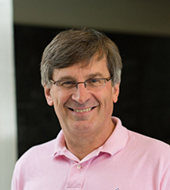
This research is carried out mainly in the subfields of nuclear and particle physics and typically involves large experimental equipment located away from MIT, sophisticated theoretical calculations, state-of-the art computers, and highly skilled engineering and technical staff. More than 80 MIT Physics Ph.D. students form the backbone of current LNS research activities worldwide. It is an exciting time for LNS and I would like to highlight some of our present activities and to invite you to explore further in the extensive information provided here.
The Large Hadron Collider (LHC) to explore the high energy frontier is now routinely operating and used by our LNS group at CERN. They have played a major role in the discovery of the Higgs particle and will continue to search for new physics at the energy frontier for the foreseeable future. In addition, LNS researchers are studying rare decays at the LHC, again motivated by the possibility of new physics. The LHC is expected to be the planet's high energy frontier accelerator for about the next two decades.
The Standard Model of the nuclear force provides a theoretical framework which explains protons, neutrons, indeed all atomic nuclei in terms of point-like quarks bound by gluons, the carriers of the color force. LNS researchers are working to understand how basic properties of the proton, e.g. mass and spin, arise from the quarks and gluons. How does the spin-½ of the proton arise? This research involves high energy scattering experiments, theoretical calculations, and large scale computer simulations. Further, the phases of the theory of the strong interaction are explored in ultra-relativistic heavy ion collisions using high energy colliders, including the LHC. Is matter formed at high energy and density consistent with what we expect from the Standard Model?
It is widely believed that the matter we are made of, atomic nuclei, is only a small fraction of the total matter in the universe and that our Milky Way Galaxy contains a large amount of weakly interacting, non-rotating dark matter. LNS physicists are developing ingenious detectors to look for direct evidence of this dark matter. In particular, the LNS detectors will be able to measure the direction of the dark matter velocity. A new experiment DarkLight, has been approved at Jefferson Lab to look for a dark photon which can couple leptons to dark matter.
The Alpha Magnetic Spectrometer (AMS) was successfully installed on the International Space Station in May 2011. Data taking has continued smoothly since that time and important new data have been released. In particular, the positron spectrum versus energy shows a significant change compared to other previous data. It can be a sensitive test of the existence of dark matter. It is expected that AMS will continue to take data beyond 2020.
The Laboratory for Nuclear Science (LNS) was established in 1946 to provide support for basic research by faculty and research staff members in the fields of nuclear and high energy physics.
Neutrinos are weakly interacting, uncharged particles which come in three flavors and play a key role in the Standard Model. Recent experiments have shown that they have mass and that they can oscillate within their three flavors. LNS physicists are working to determine the electron neutrino mass and are carrying out reactor-based oscillation experiments to explore subtle properties of the neutrino.
Why is the universe made of matter and not anti-matter? The answer to this most fundamental question is not yet understood: at the time of the Big Bang, matter and antimatter should have been made in equal quantities, with mutual annihilation ensuring that nothing was left behind but energy in the form of light, radio waves, X-rays and so on. A small and subtle asymmetry in the laws of physics, however, led to the matter-dominated Universe that we know today. That same asymmetry should lead to a tiny distortion in the shape of a subatomic particle called the neutron. LNS physicists are studying the neutron response to electric and magnetic fields with the goal of measuring time-reversal violation, the signature of this distortion.
LNS physicists are studying the neutron response to electric and magnetic fields with the goal of measuring time-reversal violation, the signature of this distortion.
MIT Center for Theoretical Physics - A Leinweber Institute is engaged in a broad range of fundamental research in theoretical physics in support of the above activities as well as in string theory, cosmology, and quantum computing. Recently discovered connections between string theory and the Standard Model theory of the strong interaction are being actively investigated.
New detectors and accelerators are essential for progress in research. At LNS these are developed using the staff and facilities at the Bates Research and Engineering Center, located about 20 miles north of Boston in Middleton, MA. Novel tracking detectors have been developed at Bates to allow measurement of the polarization of the anti-quarks in the proton using high-energy proton-proton scattering. In addition, a new high intensity, polarized electron source is under development there. This is required for a high intensity, polarized electron-ion collider, under consideration as the next generation accelerator to study the strong interaction. At Bates, MIT researchers have developed new techniques using small accelerators for important societal applications, e.g. to screen cargo for dangerous materials and to treat cancer. Bates is also the location of the new High Performance Research Computing Facility for analysis of LHC data, as well as for sophisticated computer calculations by other MIT researchers.
Thank you for visiting our LNS web site. Hopefully, you will find it useful and informative. If I or any of my LNS colleagues can be of further assistance feel free to contact us using the Directory.
Boleslaw Wyslouch
Cambridge, Massachusetts